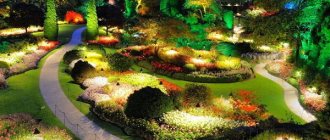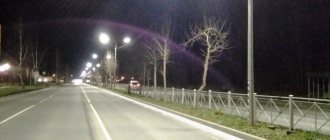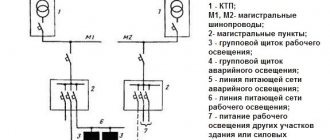Where to start calculating outdoor street lighting?
Comfort and safety are relative concepts, but they have certain indicators. There is no need to guess what level of illumination will be required for the street. It is enough to refer to the regulatory documents.
According to GOST R 55706-2013, road network objects are divided into classes, each of which requires a certain brightness of artificial light. The indicator is measured in candelas per square meter (cd/m2). Candel is a unit of luminous intensity.
For example:
· Class A (1.2-2.0 cd/m2) includes roads with heavy traffic (highways, federal highways).
· Class B (1-1,2) combines urban and regional routes.
· Class B (0.4-0.8) consists of roads in residential areas in the city center and beyond, as well as industrial areas.
· Class P (0.1-0.3) includes pedestrian streets, alleys, sidewalks, squares in front of public buildings.
You can also find in this GOST information regarding the average illumination of objects, measured in Lux (lx).
Values for the most popular objects:
· The area in front of the entrance to the entertainment building is 20,
· Pedestrian streets and playgrounds – 10,
· Entrance to the park or stadium – 6,
· Sidewalks – 4,
· Central and secondary alleys of parks – 2.
Another document that will help calculate street lighting is SNiP 05/23/95. Here are the values of horizontal illumination (lx) of many urban infrastructure objects:
· Bridges for pedestrians – 10,
· Sports grounds – 10,
· Approaches to various sites – 4,
· Shopping center area – 4.
SNiP 23-05-95 is also useful for calculating the external illumination of facades and shop windows, taking into account the requirements for facade brightness and the degree of reflection depending on the finishing material.
7.28 Lighting of streets, roads and squares with regular traffic in urban settlements should be designed based on the standard of average brightness of improved coatings according to Table. eleven.
Lighting of streets, roads and squares of urban settlements located in the northern building-climatic zone of the Asian part of Russia and north of 66° north latitude in the European part of Russia should be designed based on the average horizontal illumination of roadway surfaces according to Table. eleven.
The level of illumination of the carriageway of streets, roads and squares with transitional and lower types of surfaces in urban settlements is regulated by the value of the average horizontal illumination, which for streets, roads and squares of category B should be 6 lux, for streets and roads of category B with a transitional type of surface - 4 lux and for lower type coatings - 2 lux.
Notes
1 Categories of streets and roads of cities by functional purpose are accepted in accordance with the classification of chapter SNiP 2.07.01.
2 Road surfaces are classified as advanced, transitional or inferior types according to classification. 7.29 The average brightness of the pavement surfaces adjacent to the carriageway of streets, roads and squares must be at least half the average brightness of the carriageway surfaces of these streets, roads and squares given in Table. eleven.
7.30 The ratio of the minimum brightness of coatings to the average value must be at least 0.35 when the average brightness standard is more than 0.6 cd/sq.m and not less than 0.25 when the average brightness standard is 0.6 cd/sq.m and below.
The ratio of the minimum pavement brightness to the maximum along the traffic lane must be at least 0.6 when the average brightness standard is more than 0.6 cd/sq.m and not less than 0.4 when the average brightness standard is 0.6 cd/sq.m and below.
Table 11
| Object category by lighting | Streets, roads and squares * | Maximum traffic intensity in both directions, units/hour | Average brightness of the coating, cd/sq.m | Average horizontal illumination of the coating, lux |
| 1 | 2 | 3 | 4 | 5 |
| A | Main roads, main streets of citywide importance | St. 3000 St. 1000 to 3000 From 500 » 1000 | 1,6 1,2 0,8 | 20 20 15 |
| B | Main streets of district significance | More than 2000 More than 1000 to 2000 From 500 » 1000 Less than 500 | 1,0 0,8 0,6 0,4 | 15 15 10 10 |
| IN | Local streets and roads | 500 or more Less than 500 Single cars | 0,4 0,3 0,2 | 6 4 4 |
| _____________ * The area category is adopted according to the table. 18. Notes 1 The average brightness of highway pavement, regardless of traffic intensity, is assumed to be 1.6 cd/sq.m within the city and 0.8 cd/sq.m outside the city at the entrances to airports, river and sea ports of the largest cities. 2 The average brightness or average illumination of the roadway surface within the boundaries of a transport intersection at two or more levels on all intersecting highways should be both on the main one and on exits and branches within the city - at least 0.8 cd/sq.m , or 10 lux. | ||||
7.31 The average horizontal illumination at the level of coverage of impassable parts of streets, roads and squares, boulevards and squares, pedestrian streets and microdistrict territories in urban settlements should be taken according to Table. 12.
Table 12
| Illuminated objects | Average horizontal illumination, lux |
| 1 | 2 |
| 1 Main pedestrian streets, impassable parts of areas of categories A and B and pre-factory areas | 10 |
| 2 Pedestrian streets: | |
| within community centers | 6 |
| in other territories | 4 |
| 3 Sidewalks separated from the roadway on streets of categories: | |
| A and B | 4 |
| IN | 2* |
| 4 Landing areas for public transport on streets of all categories | 10 |
| 5 Pedestrian bridges | 10 |
| 6 Pedestrian tunnels: | |
| during the day | 100 |
| evening and night | 50 |
| 7 Stairs of pedestrian tunnels in the evening and at night | 20 |
| 8 Pedestrian paths of boulevards and squares adjacent to category streets (Table 11): | |
| A | 6 |
| B | 4 |
| IN | 2 |
| Territories of microdistricts 9 Driveways: | |
| basic | 4 |
| secondary, including sidewalks and entrances | 2 |
| 10 Utility areas and waste disposal areas | 2 |
| 11 Children's playgrounds at the locations of equipment for outdoor games | 10 |
| _____________ * The norm also applies to the illumination of sidewalks adjacent to the roadway of streets of categories B and C with transitional and lower types of surfaces. | |
7.32 On the main pedestrian streets of historical cities, the average semi-cylindrical illumination should be at least 6 lux.
7.33 The average horizontal illumination of the areas of public buildings should be taken according to table. 13. Table 13
| Illuminated objects | Average horizontal illumination, lux |
| 1 | 2 |
| Kindergartens, secondary schools and boarding schools, educational institutions | |
| 1 Group and physical education areas | 10 |
| 2 Areas for outdoor games, recreation areas | 10 |
| 3 Passages and approaches to buildings and sites Sanatoriums, holiday homes | 4 |
| 4 Entry to the territory | 6 |
| 5 Driveways and passages to dormitories, dining rooms, cinemas and similar buildings | 4 |
| 6 Central alleys of the park area | 4 |
| 7 Side alleys of the park area | 2 |
| 8 Areas for quiet recreation and cultural services (public recreation areas, areas in front of open stages, etc.)* | 10 |
| 9 Areas for board games, open reading rooms | 10 |
| _____________ * The illumination of tables for reading and board games is taken according to the standards of room illumination. | |
7.34 The average horizontal illumination of the territories of parks, stadiums and exhibitions should be taken according to table. 14.
Table 14
| Illuminated objects | Average horizontal illumination, lux | ||||
| city parks | district gardens | stadiums | Exhibitions | ||
| 1 | 2 | 3 | 4 | 5 | |
| 1 Main entrances | 6 | 4 | 10 | 10 | |
| 2 Auxiliary inputs | 2 | 1 | 6 | 6 | |
| 3 Central alleys | 4 | 2 | 6 | 10 | |
| 4 Side alleys | 2 | 1 | 4 | 6 | |
| 5 Public recreation areas, areas in front of the entrances to theaters, cinemas, exhibition pavilions and open-air stages; board game areas | 10 | 10 | — | 20 | |
| 6 Recreation areas on the exhibition grounds | — | — | — | 10 | |
7.35 The average horizontal illumination at the level of coverage of streets, roads, driveways and squares of rural settlements should be taken according to table. 15.
Table 15
| Illuminated objects | Average horizontal illumination, lux |
| 1 Main street, squares of public and shopping centers | 4 |
| 2 Streets in residential areas: | |
| main | 4 |
| secondary (alley) | 2 |
| travel | 2 |
| 3 Village road | 2 |
| Notes 1 The average illumination of the main passages on the territory of gardening partnerships and dacha cooperatives should be 2 lux, of other passages - 1 lux. 2 On the territory of blocks of outbuildings and sheds located outside the residential zone of rural settlements, the average illumination of passages between rows of buildings should be 1 lux. | |
7.36 The illumination of sections of highways of the general network within rural settlements should be taken as for streets of category B, depending on the type of road surface according to table. 11 or in accordance with clause 7.28 of these standards.
7.37 External lighting projects must provide for lighting of entrances to fire-fighting water sources if they are located on unlit parts of streets or driveways. The average horizontal illumination of these entrances should be, lux:
in cities and towns………………. 2 in rural settlements ……… 1 In projects for external lighting of streets and roads of categories A and B, it is necessary to provide for lighting of sections of unlit adjacent streets and roads (according to the lighting standards for these streets and roads) with a length of 100 m.
7.38 The lighting standard for tram tracks located on the roadways of streets must correspond to the street lighting standard. The average horizontal illumination of a separate tram track should be 6 lux.
7.39 The average horizontal illumination of the road surface of the roadway of urban transport tunnels with a length of more than 60 m should be taken in daytime according to Table. 16, and in evening and night modes equal to 50 lux. For a tunnel length of up to 60 m, the average illumination of the road surface should be 50 lux in all modes.
7.40 The average horizontal illumination of the pavement of passages under overpasses and bridges at night must be at least 30 lux for a passage length of up to 40 m, and for a longer length it is taken according to the standards for tunnel lighting in accordance with clause 7.39.
7.41 In areas where vehicles are refueled and stored, the average horizontal illumination should be taken according to table. 17.
Table 16
| Tunnel length, m | Presence of a slope of descent to the portal | Orientation of the entrance portal | Average horizontal illumination, lux, at a distance from the beginning of the entrance portal, m | ||||||
| 5 | 25 | 50 | 75 | 100 | 125 | 150 or more | |||
| From 1 to 100 | Not taken into account | Any | 750 | 750 | 400 | 150 | 60 | — | — |
| More than 100 | No slope | North South | 750 1000 | 750 1000 | 400 550 | 150 250 | 75 100 | 60 60 | 50 50 |
| With a slope | Any | 1250 | 1000 | 650 | 350 | 125 | 60 | 50 | |
| Note - In table. The 16th step of reducing the illumination levels of successive sections of the entry zone meets the requirements for creating the necessary conditions for adaptation of the driver entering the tunnel. | |||||||||
Table 17
| Illuminated objects | Average horizontal illumination, lux |
| Gas stations 1 Fuel dispenser area | 20 |
| 2 Zone of technological wells | 10* |
| 3 The rest of the territory with a roadway | 10 |
| 4 Access routes from streets and roads: | |
| categories A and B | 10 |
| category B | 6 |
| Parking lots 1 Open | |
| on streets of all categories | 4 |
| off-street tolls | 4 |
| in microdistricts | 2 |
| 2 Driveways between rows of box-type garages | 4 |
| _____________ * The minimum illumination on the well cover is standardized. | |
7.42 The ratio of maximum illumination to average should be at the average illumination standard: St. 6 lux - no more than 3:1, from 4 to 6 lux - no more than 5:1, less than 4 lux - no more than 10:1.
7.43 Lighting standards are allowed to be increased in the capitals of sovereign republics, hero cities, historical, resort and port cities of republican significance, as well as in the largest and largest cities:
a) by 0.2-0.4 cd/sq.m - for lighting installations of streets, roads and squares of categories A and B with improved types of coatings;
b) up to 20 lux - for lighting installations of impassable parts of areas of categories A and B and pre-factory areas, main entrances of stadiums and exhibitions;
c) up to 10 lux - for lighting installations of streets and roads of category B with transitional types of surfaces and the main entrances of city parks.
7.44 At night, it is allowed to provide for a reduction in the level of external lighting of city streets, roads and squares with a standardized average illumination of 4 lux, or an average brightness of 0.4 cd/sq.m or more by turning on no more than half of the lamps, excluding turning off two consecutively located , or using a luminous flux regulator for high-pressure discharge lamps to a level not lower than 50% of the nominal level without turning off the lamps.
In order to obtain additional energy savings in the evening and morning darkness, it is allowed to reduce the lighting level with the regulator:
by 30% when traffic intensity decreases to 1/3 of the maximum value;
by 50% when reducing the intensity to 1/5 of the maximum value.
On streets and roads with standardized values of average brightness of 0.3 cd/sq.m, or average illumination of 4 lux or less, on pedestrian bridges, parking lots, pedestrian alleys and roads, internal, service and fire passages, as well as on the streets and on the roads of rural settlements, partial or complete shutdown of lighting at night is not allowed.
7.45 On streets, roads and transport zones of areas of categories A and B, the glare indicator for lighting installations should not exceed 150.
For lighting installations of streets and roads of category B, as well as lighting installations, the level of illumination of which is regulated by the standards of horizontal or semi-cylindrical illumination, the minimum height of the luminaires according to the conditions for limiting glare should be taken according to Table. 10.
Exterior lighting fixtures installed on the walls of buildings should not illuminate the windows of residential buildings.
7.46 In outdoor lighting installations, luminaires with high-pressure discharge light sources should be used, including for installations for lighting streets and roads with traffic - mainly with high-pressure sodium lamps.
7.47 The height of placement of lighting devices on streets, roads and squares with tram and trolleybus traffic should be taken in accordance with SNiP 2.05.09.
7.48 The minimum installation height of lamps in the parapets of bridges and guideways is not limited, provided that a protective angle of at least 10° is ensured and the possibility of accessing the lamps without the use of a special tool is excluded.
7.49 In transport tunnels, lamps with a protective angle of at least 10° must be used. The height of their location must be at least 4 m.
7.50 In pedestrian tunnels, lamps with a protective angle of at least 15° should be used:
with fluorescent lamps with a total power of up to 80 W;
with DNAT (DNaS) lamps with power up to 110 W;
with DRL lamps with power up to 125 W.
Methods for calculating outdoor lighting
Today in practice there are three methods used for lighting calculations of outdoor lighting :
· Spot – the essence of the method is to calculate indicators for each installed light source. Its advantage is the ability to calculate uneven light. And its main drawback is its labor intensity. This manual method requires special attention and pedantry of the designer.
· With luminous flux coefficient - an even more labor-intensive method that takes into account the reflectivity of objects, the distribution of radiation, and the use of luminous flux. Most often used for interior lighting design.
· The specific power method is the most popular among manual methods due to its simplicity (relative to the previous two options). With its help, you can find the required number of lighting fixtures, based on standard indicators and simple initial data.
Depending on the task at hand, you can use different formulas. Mathematical calculations are needed not only to ultimately comply with lighting standards, but also to use the required number of lighting fixtures. After all, every extra element is not only the cost of its purchase, but also the cost of installation and maintenance.
An example of lighting calculations for external lighting of a children's playground near a house
Let's say you are planning to move to a townhouse, where there is a free 150 square meters for a playground, all that remains is to equip it and install a certain number of lights. But which one?
Let's calculate using the formula:
L = E*S*N*K / (F*X), where
L is the required number of lighting fixtures.
E – illumination (lux). Let’s immediately look at SNiP and take the number 10.
S – area, which by condition is equal to 150 square meters.
N – coefficient of uneven illumination. Essentially, it is the ratio of maximum to minimum illumination. For different types of lamps, its different values are set: 1.15 for incandescent lamps, 1.1 for fluorescent lamps, 1 – often used for LED lamps.
K is another useful coefficient that helps take into account the decrease in lamp brightness due to contamination, dust or worn glass during long-term use. The value depends on many factors, ranging from the type of lamps to the degree of dust in the space. Let's assume that the townhouse is located in a clean area, then K will be equal to: 1.5 for incandescent lamps, 1.4 for discharge lamps, 1 for LED lamps. The value of this coefficient is another reason to choose the LED option. After all, the final quantity will be smaller, which means installation costs will also be lower. A good option would be Ziverd street lamps.
F – luminous flux of one lamp. This is a numerical expression of the amount of light emitted, measured in Lumens (lm). Usually indicated in the technical documentation for the device. If you can't find this value, you can multiply the lamp power by the luminosity factor. In our case, the indicator is specified by the manufacturer and is equal to 3735 lm.
X is a coefficient that is determined based on the reflectivity of objects and buildings on the territory of the site being developed. To find it, we can turn to the same SNiP. Let’s assume that only the façade of the house, decorated with pink sand-lime brick, will interfere with the uniformity of light distribution. In this case, replace “X” with 0.3.
The data is known, let’s move on to calculating the lighting of the playground with a street lamp:
L = 10*150*1*1 / (3735*0.3) = 1.34.
Thus, you can install one lamp of the specified power, or two of lower power.
Energy saving in outdoor lighting
In our country, for most of the year, darkness prevails over daylight, so the cost of outdoor lighting amounts to billions of rubles. Various measures are being taken to reduce energy consumption, including the widespread introduction of LED outdoor lighting systems. The growing popularity of LED lamps is due to the fact that they are more economical than fluorescent and gas-discharge lamps and do not require repairs or replacement of lighting elements for several years.
An example of calculating street lighting of a roadway in a residential area
The calculation of LED street lighting for a highway is based on Let’s say the road width is 6 meters, and Ziverd cantilever lamps on poles 9 meters high.
The formula is quite simple:
F = L*K*π/N, where
F is the required distance in meters.
L – road surface brightness. The calculated road belongs to class B3, for which the brightness of the surface is 0.6 cd/m2.
K is the incandescence coefficient, which for an LED device is equal to 1.
π = 3.14.
N is the luminous flux coefficient, which will be 0.05.
Calculation of street lighting with LED lamps with numerical data:
F = 0.6*1*3.14/0.05 = 37.68.
Thus, lights need to be installed every 37.68 meters.
Examples and ideas for road and street lighting
Modern street lights add a touch of architectural design to street and road lighting without compromising safety or code compliance.
- Related Posts
- Incandescent lamp: characteristics and features.
- Lamps with e14 base: advantages and disadvantages
- Why are chokes (ballasts) needed for fluorescent lamps?
Alternatives to manual street lighting calculations
In order for the reality after installing lanterns or floodlights to correspond to expectations, it is necessary to take into account a lot of factors. The final result can be affected by the properties of the lamps, the angle of the supports, aiming and glare, placement options for lighting devices and much more. Software products help to take into account a large number of factors and minimize errors.
The most popular among designers:
· Dialux – is able to take into account even weather conditions, build 2-dimensional and 3-dimensional models, and create video visualizations.
· Light-in-Night Road is a powerful tool for online calculation of street lighting for various objects from local roads to multi-level road junctions, highways and overpasses.
· NanoCAD – allows you to make accurate calculations and create design documentation, has a fairly simple interface.
The listed services have both free and commercial versions, supplemented with databases of lamps, and open up wide visualization possibilities. Programs are also an excellent opportunity to check and analyze the correctness of the calculations made. In addition, their use is necessary when it comes to an individual project, for example, a holiday park with a unique layout and personal landscape design.
Another alternative to using formulas is a street lighting calculator. Just enter the necessary parameters, and in a couple of seconds you will get the desired result.
What you need to know about city lighting?
- When it comes to lighting paths for pedestrians and park areas, diffused light is used. This effect is achieved thanks to the specific design of the lampshades. Their power can range from 40 to 120 W.
- Illumination of buildings and structures (for example, house numbers). Special lamps and spotlights are used here.
- Decorative lighting. A variety of lighting devices are used depending on the purpose of the object.
Illumination of buildings with special spotlights
Since street lighting is influenced by a number of climatic factors, specific requirements are imposed on them. For street lighting devices, important indicators are:
- lamp power,
- lifetime,
- luminous efficiency
- device maintenance,
- climatic conditions in a certain area,
- traffic intensity,
- specifics of installation and installation.
Each street lighting device has its own passport, which indicates its parameters. The main indicator is the degree of security of the device. This is, first of all, the level of protection of the device from moisture penetration into it (indicator from 1 to 6) and the level of protection from dust and solid particles entering the lamp (from 1 to 8).
It is worth understanding that the brightness of the flashlight should illuminate the area as much as possible, but at the same time not blind the eyes of road users. When traffic on the road is inconsistent, it is advisable to use reflective lighting. That is, the lights have special sensors that are triggered by movement. They are often used to illuminate sidewalks.
Lighting of roads and sidewalks
How to check the correctness of the calculation of an outdoor lighting fixture?
Regardless of whether you used the manual method or an online calculator, the main thing is the result. Visually it is quite difficult to determine that the standards have been met. Even if your eyes are comfortable at first, too bright or dim light can quickly become boring or harmful.
Luxmeters are used to check illumination. It is enough to turn on the device, and it converts light energy into current, showing the exact value on the display. There are also models that measure the brightness of light.
About the advantages of LED street lamps
As mentioned above, the coefficients of uneven illumination and dimming are lower for LED lamps. In addition, having a lower wattage than fluorescent and incandescent lamps, they provide greater luminous flux.
A wide range of LED devices opens up possibilities for lighting design. And the addition of motion sensors saves energy resources. The main thing is their correct setting, taking into account the flow of traffic, traffic intensity in pedestrian areas, and the likelihood of birds and animals moving.
LED technology has a long service life, which means lamp replacement costs will be lower. And most importantly, LED is an investment in an environmentally friendly future. Containing no harmful materials, they are environmentally friendly and do not require additional disposal costs.
Trust modern technologies – create high-quality lighting solutions!
What is street lighting like?
In the manufacture of lighting fixtures intended for outdoor use, various materials are used:
- glass,
- plastic,
- forging,
- steel.
Depending on the geographical location, lighting devices can be made in different styles. When there is a specially developed design project, the street lighting can be made in the Baroque style, or high-tech, etc.
High-tech street lighting sources
It is worth understanding that external lighting is divided into main types:
- street lighting,
- roadway lighting,
- external, including decorative,
- pedestrian paths and sidewalks.
There is also a difference in the light sources themselves. They are:
- Fluorescent lamps. They are characterized by a long service life and high luminous efficiency. In addition, they are quite economical, operate silently and have small dimensions.
- Induction lamps. These are electrodeless lamps that operate thanks to a gas cylinder located together with an inductor. Light is produced by plasma.
- Xenon lamps. The light here comes from an electric arc located between two electrodes. Due to the internal content of such lamps, light radiation here can be of a different spectrum.
- Incandescent lamps. They have high power and good heat dissipation, but at the same time they are quite expensive. A separate type of such lamps is halogen, which have a longer service life. This is due to a special additive in the form of a buffer gas.
- Mercury lamps. The basis of the work is the formation of a gas discharge in mercury vapor. When lighting of streets and roads is necessary, general purpose lamps are used. They are economical, therefore, when there is a need to illuminate large areas, their use will be advisable.
- Solar powered lighting. This is a separate type of street lighting device, which is the most economical. The main feature is that there is no need for human participation in the operation of such devices, since there is no connection to the electrical network. They can be used both to illuminate private courtyards and to illuminate city streets. When it is light outside, these lights turn off automatically. And throughout the day they accumulate energy, which they release at night. They are used not only as lanterns, but also as decorative street lighting.











